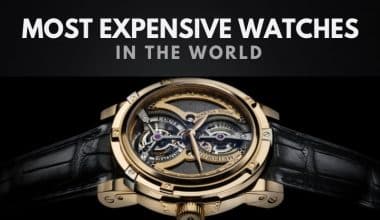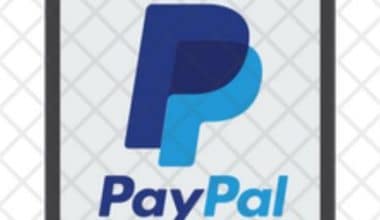The word “Forbes” on the magazine cover is familiar to most of us because it hasn’t changed much in a few decades. There were many changes before that, though—the magazine made numerous typeface and design experiments. In this article, we will be dealing with the Forbes logo, its history, and its evolution.
Who is Forbes
One of the most potent family-owned brands in the world is Forbes. A simple logo has been the face of the business that has perfected the art of writing, editing, and publishing business articles for more than a century and counting.
The Forbes logo has a simple design with a white wordmark set against a black background. The white and black colors of the logo make the company look clean, trustworthy, appealing, and easy to recognize.
This simple symbol works well to get the message across to powerful and wealthy business owners all over the world. It talks to these influential people through magazine covers, websites, social media accounts, and other channels.
Read Also: HARVARD LOGO: Meaning, Font, Course and Rate
Company History
Forbes magazine was started on September 15, 1917, by B. C. Forbes, who wrote a financial column for the Hearst papers, and Walter Drey, who was the general manager of the Magazine of Wall Street. Drey provided the publishing expertise, while Forbes provided the money and the name. Forbes: Devoted to Doers and Doings was the magazine’s original name. Drey was vice president of the B.C. Forbes Publishing Company, a position that C. Forbes held until his death in 1954. Bruce Charles Forbes (1916–1964) and Malcolm Forbes, Forbes’ two eldest sons, provided support for him in his later years (1917–1990).
After his father passed away, Bruce Forbes took over, and he was best at streamlining processes and creating marketing strategies. From 1954 to 1964, under his leadership, the magazine’s circulation nearly doubled.
After Bruce Forbes passed away, his brother Malcolm Forbes took over as president, chief executive, and editor-in-chief of Forbes, James Michaels edited Forbes from 1961 to 1999. In 1993, while under Michaels’ editorship, Forbes was a finalist for the National Magazine Award In 2006, an investment group called Elevation Partners, which includes the rock star Bono, purchased a minority interest in the business through a new company called Forbes Media LLC
Sale of the Corporate Headquarters
In 2014, the company moved its headquarters to the Newport neighborhood in the center of Jersey City, New Jersey. In January 2010, Forbes sold its Fifth Avenue headquarters building in Manhattan to New York University; however, the financial details of the deal were not made public.
Minority shareholders, Elevation Partners, persuaded Forbes Media, which publishes Forbes magazine, to put itself up for sale in November 2013. Forbes reportedly asked for a price of US$400 million in sale documents prepared by Deutsche Bank, which stated that the publisher’s 2012 earnings before interest, taxes, depreciation and amortization were US$15 million. In July 2014, the Forbes family acquired Elevation, and in August of the same year, Hong Kong-based investment firm Integrated Whale Media Investments acquired a 51 percent stake in the business.
“Since that purchase, there have been several instances of editorial meddling on stories involving China that raise questions about Forbes magazine’s commitment to editorial independence,” Isaac Stone Fish wrote in The Washington Post.
Merger of SPAC
By merging with a special-purpose acquisition company called Magnum Opus Acquisition and beginning to trade as FRBS on the New York Stock Exchange, Forbes announced their plans to go public on August 26, 2021. According to report, cryptocurrency exchange Binance would buy a $200 million stake in Forbes as a result of the SPAC floatation.
On the weekly Fox television program, Forbes on Fox and on Forbes on Radio, Steve Forbes and the contributors to his magazine offer investment advice. There are also business divisions like the Forbes Conference Group, the Forbes Investment Advisory Group, and Forbes Custom Media. According to a 2009 Times article, “Steve Forbes recently returned from opening up a Forbes magazine in India, bringing the number of foreign editions to 10” Moreover, that year, the business started publishing ForbesWoman, a quarterly magazine published by Steve Forbes’s daughter, Moira Forbes, with a companion Web site
The business used to put out American Legacy magazine as a joint venture, but on May 14, 2007, the magazine broke up with Forbes.
The company has previously published the magazines American Heritage and Invention & Technology. As of May 17, 2007, these two magazines were put on hold by Forbes after they were unable to find a buyer. Both magazines were then bought by the American Heritage Publishing Company, which started publishing them again in the spring of 2008.
The Forbes Travel Guide has been published by Forbes since 2009
In 2013, Forbes gave Ashford University the rights to use its name and helped them start the Forbes School of Business & Technology. In 2018, the licensing was explained by Forbes Media CEO Mike Federle, who said, “Our licensing business is almost pure profit because it’s an annual annuity.” Forbes would launch limited promotions for the school in limited issues, but would never formally endorse the institution.
Forbes magazine announced on January 6, 2014, that it was launching a social networking app called “Stream” in collaboration with app creator Maz. Through Stream, Forbes readers can access content from Forbes magazine and Forbes.com within the app, save and share visual content with other readers, and find new content.
Forbes.com
Forbes Media LLC’s subsidiary Forbes Digital, which includes Forbes.com, owns a piece of RealClearPolitics. Each month, more than 27 million unique visitors visit these sites collectively. The 2009 Times report stated that while “one of the top five financial sites by traffic [throwing] off an estimated $70 million to $80 million a year in revenue, it never generated the hoped-for public offering,” while using the motto “Home Page for the World’s Business Leaders.”
The Forbes.com “contributor model” pays “contributors” based on traffic to their individual pages; the site has received contributions from over 2,500 people, and some contributors have earned over $100,000, according to the company. People have said that the contributor system makes “pay-to-play journalism” and the repackaging of public information possible. In July 2018, Forbes removed a piece written by a contributor who advocated for the closure of libraries and the opening of bookstores by Amazon in their place.
David Churbuck launched the Forbes website in 1996. In 1998, the website told The New Republic about how journalist Stephen Glass had lied, which led to an article that made internet journalism more popular. In addition to running five additional stories by Michael Fumento disputing the basic media premise of Toyota’s cars gone bad, it revealed the California “runaway Prius” as a fake at the height of media coverage of the supposed Toyota’s sudden, unintended 2010 acceleration. A big reason why the website is so popular is that it has many lists of billionaires and their assets, especially their expensive homes. better source needed
The 2020 Webby People’s Voice Award for Business Blog/Website went to Forbes
Forbes8
The on-demand video network Forbes8, which Forbes describes as “Netflix for entrepreneurs,” launched its streaming platform in November 2019 and debuted a slate of original content geared toward business owners. The network said that several documentary series, such as Forbes Rap Mentors, Driven Against the Odds, Indie Nation, and Titans on the Rocks, will come out in 2020.
Business Council of Forbes
The Forbes Business Council was launched as an invite-only platform and is open to SMEs and MSMEs across the globe. The councils charge a fee to join. Business owners and founders can work together on the platform, connect with people who share their interests, and post content to Forbes.com.
History of Forbes Logo
Forbes has been around for a long time, so its logo has changed with the times. The Forbes logo has gone through numerous updates for this single reason. We’ll examine the most notable ones in this article. Therefore, let’s go right to the design studio:
Forbes: Devoted to Doers and Doings was the original name of the renowned publication. It was developed jointly by two friends: Wall Street CEO Walter Drey and journalist Bertie Charles Forbes, of Scottish descent. The first gave him his name and financial backing; the second gave him experience in publishing. As soon as Walter took over the B.C. Forbes Publishing Company, Bertie Charles became the magazine’s editor-in-chief. Up until his passing, he held this position.
After 1954, the father’s business was taken over by his sons. Malcolm Forbes was editor-in-chief of the magazine, and Bruce Charles Forbes became president and CEO of the company that bore his name. They significantly increased the publication’s prestige, grabbing readers’ attention and bringing in new customers. These days, the print edition has an online platform as well. So, in 2014, the Hong Kong investment group Integrated Whale Media Investments bought the Forbes publishing company.
Because the magazine is famous for its very clear business perspective, the entire world is on par with it. He is famous for his consistent rankings, which include top lists of the world’s billionaires, influential people on the planet, wealthy celebrities, the 400 richest Americans, and top global businesses (Forbes Global 2000). Because it tries to stay current and grab readers’ attention, the magazine also had a lot of logos.
In 1917 – 1918
The inscription “Forbes Magazine,” which was written in two rows and in Old English font, was placed on the debut numbers. There were bold dots with tiny curls that resembled commas at the ends of the wide letters in place of serifs. The letters “F,” “G,” “E,” “Z,” “S,” and “R” were particularly well-pronounced. There were teeny hook-like protrusions on both letters “A.” Mini serifs are used to style the letters “B,” “M,” and “I.”
Then in the Years 1918 – 1922
The logo was used during this time with thin, black letters that had traditional serifs. Since there was enough room between the signs, they did not blend together. The center-placed “R” and “B” stood out as exceptions. The first letter’s extended leg was tucked under the second. “Magazine” was deleted by the authors.
In 1922 – 1924
A new logo was approved by the magazine’s editors for the cover. It was a black rectangle. The print edition’s name could be seen between the two thin white stripes that ran along the bottom and top of the geometric shape. Furthermore, the letters were connected by lines on both sides, making the tiny protrusions from the curved serifs stand out against the background.
1924 – 1925
The 1925 redesign maintained the white-outlined logotype design but changed the typeface to a more elegant narrow one. The composition as a whole became more refined and stylish as the letters grew taller. Although the serifs at the ends of the lines became smoother, their ends became sharper.
The character designs were updated as a result of the redesign. As a result, they received a thin solid strip of black and white outlined. The serifs are corrected to be classically flat.
1925 – 1930
The logo was composed of broad, internally hollowed-out marks for the following five years. They appeared big, elongated, and almost end-to-end. F and E had crossbars that were shorter. The designers decided to keep the serifs.
1930 – 1934
The Forbes logo was written in a distinctive modern cursive with “broken” year bold and angular lines, and it was used from 1936 to 1938. Although it was a stylish and intriguing inscription, it didn’t last for very long because it lacked confidence and stability.
A half-figured inscription was present in the logo at the time. The title of the magazine featured wide-sided letters connected by brief, slender lines. F and E’s center strokes had edges that pointed outward and inward, resembling diagonal triangles.
1934 – 1937
The lowercase was introduced after many years of using block letters, and the word “Forbes” was written in shaky cursive. The writing was brief and coherent; it connected all the signs in one continuous line.
1937
The first time thin sans-serif uppercase characters were used was on the logo. As a result, the title is much more expressive, understandable, and simple to read. It was a horizontal rectangle on a light gray background that almost blended in with the background color, making it virtually invisible.
1937 – 1938
The logo’s creators chose to revert to the handwritten design after experimenting with grotesque. To make up for it, though, they changed the shapes of the letters and kept only the consistency (coherence) of the original inscription.
1938
The magazine’s title is now bold and large. The connections between the symbols were so close to fusion. Each of them was made up of a wide shadow on the right and a thin outline on the left. The magazine’s title was made three-dimensional, and the letters were given volume.
1938 – 1939
The designers changed the order of the letters and made the signs taller and thinner by making them longer. The designers added one contour strip on the left side to increase convexity.
1939 – 1953
The publication started using a big stencil font with extended black characters in 1939.
1953 – 1966
The classic serif typeface from the previous logo was still present in this one. The authors also made all the other characters smaller, even though they were all uppercase, except for the letter “F,” which they left huge.
1966 – 1973
The text on the insignia has been resized, making the letters a little bit bigger and making it easier to read. The signs have very small serifs.
1973 – 1977
The name of the logo remained the same, but the serifs were eliminated.
1977 – 1978
The magazine’s cover featured a prominent title. The designers straightened the right leg at the letter “R” and squeezed the letter “F,” shortening the protruding lines. Once more, the characters were fairly closely spaced.
1978 – 1999
The year 1978 saw a revolution in headline design. A completely different typeface—modern, chic, and elegant—was then approved. All of the other letters were changed to lowercase, except for “F,” which stayed in capital letters.
1999 – Present
The font used on the symbol is lovely since the authors made the letters a little bit narrower than they were in the previous design. They also deleted the bottom serif from “b,” added the “F” curl, and substituted a short stroke for the “r” dot. Furthermore, the title has changed to color, which is a revolution for a business journal.
The Changes in Forbes Logo
Since Forbes has endured various eras, its logo has changed to reflect those eras. The Forbes logo has undergone numerous revisions for this one basic reason. In this article, we’ll examine the most notable ones. So let’s proceed immediately to the design studio:
The Beaux-Arts Style, 1918–1923
In 1918, Forbes introduced its initial logo to the public. It had swatches surrounding the letters and was written in a wordmark style. The art and craft trend in the American printing business, which was popular at the time, is visible in the black official insignia.
The First Update: 1923–1930
During this time, Forbes used three different wordmark logos. The first two logos had white fill inside of black borders. All three varieties came in caps with various typefaces, but the third had a solid black color.
The Ford Influence, 1930–1937
The business changed its logo a second time. It chose a script wordmark logo. The logo had lowercase characters, but the letter F had what seemed like a hat on top. Sometimes, design professionals would refer to it as berserk. It was a Ford design ripoff.
The Bauhaus Influence, 1937–1938
The Forbes logo underwent the fourth revision. The script design for personalized Roman capitals was eliminated. It was excellent how the letter “O” in the design appears to be a complete circle. The six letters were separated by larger spacing, drawing attention to the logo.
The War Poster Era, 1938–1948
Forbes experimented with three distinct designs during the following ten years. It chose the script design once more, but this time it was slick and modern. Another version of it had a drop shadow, and this one appeared sophisticated and strong. The company’s previous logo was inspired by wartime propaganda.
The Breathing Logo, 1948–1966
Forbes unveiled a logo concept in 1948 that served as the model for the current logo. It had a large, all-caps wordmark logo with serifs and spikes on the edges. The letter F was a distinctive part of the design that made it readable and memorable.
The Gothic logo, 1966–1978
Forbes recognized the need for a new logo. The business unveiled a logotype with bold lettering. The font was based on a combination of serifs and Universe font, and it had a Franklin Gothic appearance.
1978-Now: The Contemporary Logo
The current official Forbes logo features a large sans-serif font. The large logotype is clear, legible, and sophisticated. In 1999, the designer made some changes to the wordmark by adding more spaces between the letters. The lettering has had a slight tweak to appear crisper.
Why Does the Forbes Logo Function?
#1. The Forbes Logo Is Reliable
Perhaps some of us feel that the Forbes logo has seen too many changes. Although this is accurate, the adjustments had no impact on the organization’s fundamental beliefs. The Forbes logo has maintained its visual components—a wordmark and colors—for over ten decades.
#2. The Forbes Logo Can Be Read
Being illegible for a company that sells “important words” to the general public would be a major mistake. The Forbes logotype is big and easy to read on all types of media, such as magazines, websites, social media sites, etc. Once it appears, you can’t miss it!
#3. The Forbes Logo Is Scrubbed
Cleaning and attention to detail are important in the writing and publishing industries. This attribute is reflected in Forbes’ well-known logo. The logo design has fewer graphic elements, which helps it get a low-key reputation. The Forbes logo distinguishes itself from the competition by using just a font and two colors.
#4. The Logo Is Recallable
Once you’ve seen the Forbes logo, it’s easier to remember it whenever you want. This is a common marketing platform because it has simple design features. This means the logo can keep its size, shape, colors, and other important qualities while still looking great on advertising platforms.
Symbol’s Font and Color Scheme
Since the Forbes logo is a combination of words, the story of its rebirth is the story of its type. In the middle years, sans serifs were the most common, while serifs were the most common in the early years. Now, tiny serifs are making a comeback.
A Nicholas Bold typeface, by designer Nick Shinn, is currently in use. Buenard Bold Font is the closest free alternative to it. The lettering has traditionally used a subdued black color scheme. Her skin turned blue in 1999.
Colors in the Forbes Logo
#1. Black Color
By selecting black as one of its brand’s colors, Forbes appears to be saying this: “I want readers to regard me as strong and elegant.” Black is a mysterious color that stands for power, money, and refinement. Black also communicates negative feelings like dread, danger, or grief, but that’s not the case with the Forbes logo’s black color. The Forbes logo stands out from the crowd because of the black and white color combination.
#2. White Color
Forbes chose white as one of its logo colors because it values order, clarity, and tranquility. White is the most neutral color. It signifies light, winter, and the heavens. Some indigenous people use white as a color to signify purity, innocence, and humility. With its wordmark painted in white, the Forbes logo design appears simple.
#3. The color blue
By using blue in some of its logos, Forbes meets the needs of its readers to trust the brand. The calming hue of blue stands for tranquility, assurance, and harmony. Additionally, it can emit feelings like stability, honesty, and oneness. The color blue signifies the sky and bodies of water.
The Forbes Logo’s Font is what?
The font used by Forbes is strikingly similar to Publico Headline Bold. In Forbes’ example, the letter r has been altered. There are four different weights of the Publico Headline font: light, medium, bold, and extra-bold. The font designers include Paul Barnes, Christian Schwartz, Kai Bernau, and Ross Milne.
What font is used in Forbes logo?
The Univers font served as the foundation for the 1966 debut of the serif-added Forbes logo. A decade later, the letters gained more weight and began to resemble Franklin Gothic.
Who was on the cover of Forbes?
Megan Thee Stallion, a rapper from Houston, makes history by appearing on the Forbes cover.
How did the Forbes family get rich?
The Forbes family, a wealthy extended American family with a long history of prominence in Boston, Massachusetts, is one of the members of the Boston Brahmins. The family’s wealth was accrued through the 19th-century trade of opium and tea between North America and China as well as other investments made during that time.
Did Forbes run for president?
At the Forbes School of Business & Technology, he serves as an advisor. In the Republican presidential primaries of 1996 and 2000, Forbes ran as a candidate.
How much money do you need to have to be in Forbes?
The threshold for inclusion in this year’s list of the richest people in America is $2.7 billion. Even if it’s less than $2.9 billion from the previous year, the threshold for membership in this exclusive club was only $1.1 billion ten years ago.
Which family has been rich the longest?
The Du Pont family fortune started in 1803, but during the American Civil War, they sold gunpowder and grew to be an incredibly wealthy family. By World War I, almost all of the gunpowder used in America was produced by the DuPont family. The Du Pont fortune was deemed to be the richest family fortune in America in 1968 by Ferdinand Lundberg.
Can you nominate yourself for Forbes?
Nominate yourself or them right now. Numerous aspects are taken into account by reporters, editors, and professional judges, such as funding, revenue, social impact, originality, and potential.
Conclusion
Once you’ve seen the Forbes logo, it’s easier to recall it whenever you want it. This marketing tool is widely in use because of its straightforward design. This means the logo can keep its size, shape, colors, and other important qualities and still look great on advertising platforms.
Related Articles
- HOW TO BECOME A BILLIONAIRE: Everything You Need To Know
- SECRET FACTS ABOUT TOP BRANDS 2023
- WENDY’S LOGO: Evolution, History, Hidden Message, Best Practices
- ACURA LOGO: Meaning, Owner, Mdx, and Car Prices
- 2023 Fortune 100 List of Companies Updated!!!
FAQs
Is Forbes American or British?
Forbes keeps readers up to date on the American economy, businesses, entrepreneurs, and their perspectives on international finance. That obviously makes it American
How much is Forbes monthly?
The subscription costs $6.99 per month. Annual: ($49.99)- readers save 40% if they choose this subscription, which is charged annually and is one of Forbes’ most popular subscription services.
What is Forbes famous for?
Forbes is perhaps popular for its lists, which include billionaires, the top 30 under 30, colleges, entertainers, and self-made women, to name a few.






